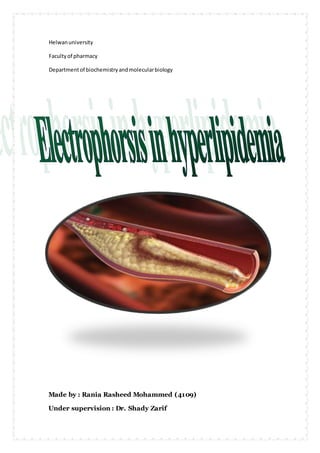
hyperlipidemia
- 1. Helwanuniversity Facultyof pharmacy Departmentof biochemistryandmolecularbiology Made by : Rania Rasheed Mohammed (4109) Under supervision : Dr. Shady Zarif
- 2. Contents: *what is hyperlipidemia ? *classification of hyperlipidemia . *primary(familial ) hyperlipidemia. *Frederickson classification of lipid disorders. *secondary(acquiered )hyperlipidemia . *electrophoresis in hyperlipidemia . *Refrences .
- 3. (1) ?hyperlipidemiaWhat is The term hyperlipidemia means high lipid levels. Hyperlipidemia includes several conditions, but it usually means that you have high cholesterol and high triglyceride levels. High lipid levels can speed up a process called atherosclerosis, or hardening of the arteries. Your arteries are normally smooth and unobstructed on the inside, but as you age, a sticky substance called plaque forms in the walls of your arteries. Plaque is made of lipids and other materials circulating in your blood. As more plaque builds up, your arteries can narrow and stiffen. Eventually, enough plaque may build up to reduce blood flow through your arteries. Atherosclerosis increases your risk of heart disease, stroke, and other vascular diseases. Fortunately, you may be able to reduce high lipid levels and, therefore, prevent or slow the progression of atherosclerosis. Lifestyle changes like exercising and eating a healthy diet can also lower your lipid levels and are often the first step in treatment. Classification of hyperlipidemia (2) Hyperlipidemias may basically be classified as either familial (also called primary) caused by specific genetic abnormalities, or acquired (also called secondary) when resulting from another underlying disorder that leads to alterations in plasma lipid and lipoprotein metabolism. Also, hyperlipidemia may be idiopathic, that is, without known cause. Hyperlipidemias are also classified according to which types of lipids are elevated, that is hypercholesterolemia , hypertriglyceridemia or both in combined hyperlipidemia. Elevated levels of Lipoprotein(a) may also be classified as a form of hyperlipidemia.
- 4. 1- Primary (familial ) : (2) Familial hyperlipidemias are classified according to the Fredrickson classification , which is based on the pattern of lipoproteins on electrophoresis or ultracentrifugation . it was later adopted by the World Health Organization (WHO) . It does not directly account for HDL, and it does not distinguish among the different genes that may be partially responsible for some of these conditions . Type I – Hyperchylomicronemia (3) Deficiency in Lipoprotein Lipase. No increased risk of heart disease. Type II ــ hypercholesterolemia (2) Type IIa ــ a rare genetic disorder characterized by increased levels of LDL cholesterol in the blood due to the lack of uptake (no Apo B receptors) of LDL particles. Type IIb ـــThe high VLDL levels are due to overproduction of substrates, including triglycerides, acetyl CoA, and an increase in B-100 synthesis. They may also be caused by the decreased clearance of LDL. Type III–Dysbetalipoproteinemia(3)
- 5. Mutation of apolipoprotein E. Increased risk of coronary & peripheral vascular disease, Xanthomas. Type IV – Hypertriglyceridemia (3) Overproduction/decreased removal of serum VLDL. Patients are frequently obese, diabetic, and hyperuricemic. Risk factors: Estrogen therapy, pregnancy, alcoholism. Type V - Mixed Hypertriglyceridemia (3) Increased production/decreased clearance of VLDL. Patients are commonly obese, diabetic. Frederickson Classification of Lipid Disorders (4) Type Average of overnight serum Elevated particles Associatedclinical disorders Serum TC Serum TG I Creamy top layer Chylomicrons Lipoprotein lipase deficiency,apolipoprotein C-II deficiency N ++ IIa Clear LDL Familial hypercholesterolemia, polygenic hypercholesterolemia, nephrosis, hypothyroidism, familial combined hyperlipidemia ++ N IIb Clear LDL, VLDL Familial combined hyperlipidemia ++ +
- 6. III Turbid IDL Dysbetalipoproteinemia + + IV Turbid VLDL Familial hypertriglyceridemia, familial combined hyperlipidemia, sporadic hypertriglyceridemia, diabetes N+ ++ V Creamy top, turbid bottom Chylomicrons, VLDL Diabetes + ++
- 7. 2-ACQUIRED (SECONDARY)(5) Acquired hyperlipidemias (also called secondary dyslipoproteinemias) often mimic primary forms of hyperlipidemia and can have similar consequences. They may result in increased risk of premature atherosclerosis or, when associated with marked hypertriglyceridemia, may lead to pancreatitis and other complications of the chylomicronemia syndrome . The most common causes of acquired hyperlipidemia are: diabetes mellitus Use of drugs such as diuretics, beta blockers , and estrogens. Other conditions leadingto acquired hyperlipidemia include: Hypothyroidism renal failure nephrotic syndrome alcohol usage Some rare endocrine disorders and metabolic disorders Treatment of the underlying condition, when possible, or discontinuation of the offending drugs usually leads to an improvement in the hyperlipidemia. Specific lipid-lowering therapy may be required in certain circumstances. Electrophoresis : (6) The Lipoproteins Electrophoresis kits are intended for the separation of lipoproteins in human serum by electrophoresis on agarose gel plates. Visual inspection of the pattern is performed to detect abnormalities, including variations of the bands or appearance of extra bands. Densitometry of the pattern allows the relative quantification of lipoprotein zones. The kits have been designed for use with the fully automated instruments Easy Interlab G26 & Pretty Interlab.